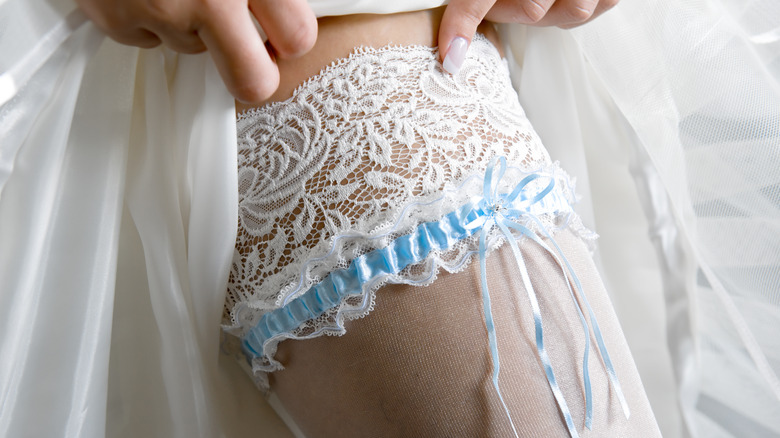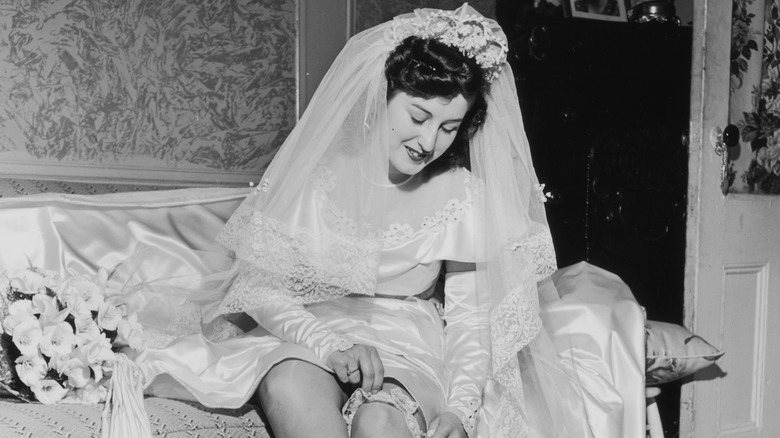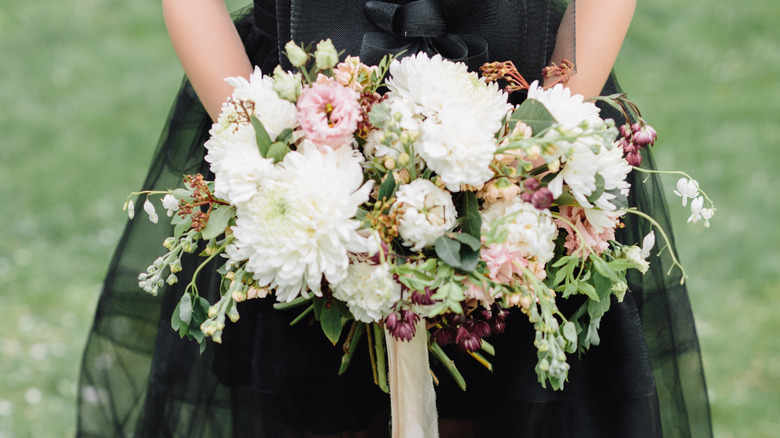The Cringey Wedding Tradition That's Totally Outdated
Let's face it, weddings include a LOT of antiquated, outdated, and some outright problematic traditions and superstitions. From wearing white and changing last names to forcing unmarried women to physically compete for flowers, the patriarchal cringe factor is high. Perhaps nowhere is this cringe more obvious than in the garter toss tradition. For those who might not know, this tradition calls for the groom/partner to, very publicly, reach up the bottom of their bride's skirt to remove her garter (a narrow band worn on the upper thigh). This removal can be done with their hands or (unfortunately) with their teeth. Cringe.
While this tradition can be modified for same-sex or non-binary celebrations, studies have shown this tradition typically persists mainly in cisgender weddings. In a cisgender celebration, the garter toss often serves as the male equivalent of the bouquet toss. Once the groom/partner has retrieved the garter in whatever fashion they choose, they toss it into an expecting crowd of unmarried men. Much like a bouquet, it's believed that whoever catches it will marry next. Not only is the garter toss a weird throwback to include in a wedding in 2023, but it also has a deeply problematic history that should make anyone think twice about participating.
The history of the garter toss
The history of how the garter toss came to be is, well, gross. During the Dark Ages, wedding guests would get wild, and by the end of the wedding, they'd rip off the bride's clothing as a way to 'encourage' the couple to 'consummate' their marriage. Even worse, it was considered good luck to have a piece of the bride's ripped dress. "Bedding ceremony" rituals varied by culture, but were extremely prevalent throughout Europe. They all included a public element (either by actively watching or waiting immediately outside) to prove the couple had completed the legally binding ritual of intercourse. This was also used as a way to prove a bride was still a virgin (insert eye roll).
Kim Forrest, Senior Editor for WeddingWire, explained to Refinery29, "Back in olden times, newly-married couples were expected to consummate their union pretty much immediately after the wedding. And family members and friends would wait outside of their room to make sure that this happened." Forrest also elaborated that, as a way to try and save the couple's clothing from destruction, the garter became a way to appease the wedding crowd, "After the marriage was consummated, the groom would give the bride's garter to the waiting crowd to prove that the deed was done." This tradition continued to change as the concept of bedding ceremony rituals grew less popular, and has morphed into the spectacle seen today (which not so subtly happens towards the end of a wedding reception).
The garter toss in 2023
It's extremely difficult to remove the foundational meaning of the garter toss from any contemporary version of the ritual that couples might attempt to use. This is especially true when you consider that, according to the director of domestic research at the Guttmacher Institute Lawrence Finer, "Premarital sex is normal behavior for the vast majority of Americans, and has been for decades." Removing the virgin element also calls into question the need to make brides wear white, but that's an article for another day.
If couples are having sex before their wedding day, which the vast majority are, then outwardly displaying proof that they are going to have sex again is both weird and unnecessary (especially for their guests). That being said, even if we can somehow move past the proof-of-sex core of this tradition, there are still other issues to contemplate. The extremely gendered elements of the tradition make it less than accessible to same-sex and non-binary celebrations. Plus, the societal reckoning of the #MeToo movement has changed how we see the physical and emotional treatment of women and their bodily autonomy. While society is still grappling with its patriarchal structures (like the concept of 'the one' for instance), it feels like a step in the wrong direction to keep aggressively patriarchal wedding traditions like the garter toss alive. Continuing a tradition steeped in a history of what amounts to physical assault is not only outdated, it's unacceptable.


